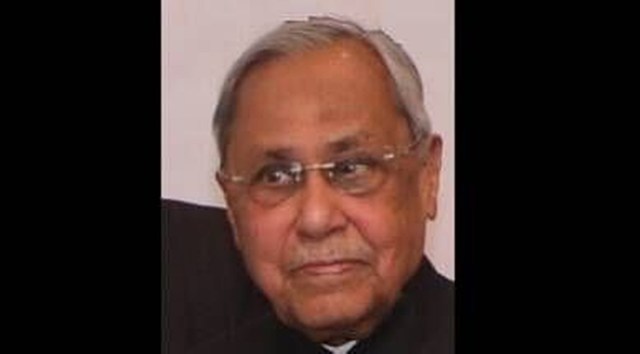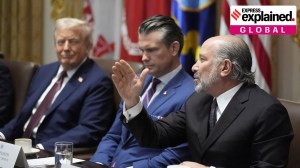Judiciously Yours: When powers-that-be sought to tinker with Constitution
The first amendment to the Constitution introduced the 9th schedule in 1951 allowed Parliament and State Legislatures to enact different laws that could be included in the 9th schedule through constitutional amendments.
 The background of the Keshvananda Bharti case can be traced back to the Constitution itself. (Express Photo)
The background of the Keshvananda Bharti case can be traced back to the Constitution itself. (Express Photo) I will soon be completing 79 years of my journey. My romance with the Constitution started in 1964, marking 59 years of togetherness.
If I were to single out one judgment that has been the savior of the Indian Constitution, democracy, and the rule of law, it would be the Keshvananda Bharti case.
We celebrated its golden jubilee on April 24, 2023. In a recent valedictory address at his alma mater, Panjab University, Justice Adarsh Kumar Goel, former Judge of the Supreme Court and currently the Chairman of the National Green Tribunal, recalled how I (as a teacher of constitutional law) had analyzed the judgment for weeks when it was pronounced.
After more than four decades, the constitutionality of the NJAC Act came up before the Constitution Bench, which included Justice Goel.
On the occasion of the golden jubilee at PU, Justice Goel shared that the classroom discussions of 1973 provided him with a sound and solid foundation. I deeply appreciated his words, as there is no greater compliment for a teacher.
The background of the Keshvananda Bharti case can be traced back to the Constitution itslf.
The first amendment to the Constitution introduced the 9th schedule in 1951.
It allowed Parliament and State Legislatures to enact different laws that could be included in the 9th schedule through constitutional amendments.
This provided a constitutional shield to these legislations, preventing them from being challenged as violative of the Constitution.
This process continued and was upheld in the Shankari Prasad (1951) and Sajjan Singh (1964) cases.
In 1967, the Golaknath case was brought before a bench of 11 judges. By a majority of 6:5, it was held that Fundamental Rights could not be curtailed or abridged even through constitutional amendments.
This judgment came as a shock and setback to the government.
The question of implied limitations on the amending power of Parliament had been gradually gaining momentum.
By 1972, 66 enactments had been included in the 9th schedule, which raised serious concerns.
In response, the government passed the 24th constitutional amendment to nullify the Golaknath decision.
The amendment practically allowed Parliament to add, modify, or repeal any part of the Constitution.
The government also wanted the Supreme Court to overrule Golaknath, and it anticipated that these developments would be challenged under Article 32.
My intention is to share this story so that such attempts are not made again, even after 50 years.
According to constitutional historian Granville Austin, the then Union Minister of Steel and Mines, Mohan Kumarmangalam, Chief Minister of West Bengal SS Ray, and Union Law Minister HR Gokhale were trusted aides of Indira Gandhi. They were the ones who nominated the judges on the bench of the Keshvananda Bharti case.
The elevation of Justice SN Dwivedi, a judge at the Allahabad High Court, was highly controversial.
On the occasion of his farewell, Justice Dwivedi remarked that he was going to the Supreme Court to overrule the Golaknath case.
The Advocate General of Uttar Pradesh was present on this occasion and later informed former Chief Justice of India M. Hidayatullah that he was shocked at the brazenness with which Justice Dwivedi revealed his predetermined mind and mission.
Chief Justice SM Sikri expressed his disapproval of Justice Dwivedi’s appointment, citing his junior status and lack of judicial impact.
He also disclosed to Justice Reddy that the government had exerted significant pressure to appoint Justice Dwivedi, implying political manipulation.
Interestingly, all the judges, except Justice Mukherjea, favored the government in the Keshvananda case.
In his memoirs, Justice PJ Reddy observed that the judges seemed closed-minded and predetermined in their views.
An intriguing exchange took place between Justice Dwivedi and Nani Palkhivala during the proceedings.
Justice Dwivedi mistakenly offered an assurance to Palkhivala regarding property rights, despite Palkhivala advocating for an “implied limitations theory.”
This prompted surprise and confusion, as Dwivedi lacked the authority to make such a guarantee.
Later, Dwivedi expressed regret to Justice Reddy for his remark.
Nani Palkhivala shared his concerns with Granville Austin, highlighting the unbelievable pressure experienced by the judges during those days.
The Attorney General, Niren De, even threatened dire consequences if the judgment went against the government.
Justice Reddy, in his concurring judgment, stated that the court should not be swayed by the potential consequences, as long as the decision adhered to the law.
Justice Reddy believed that Justice Mukherjea was coerced with the offer of a higher position if he agreed, but Mukherjea stood firm in his refusal.
Reddy wrote that Mohan Kumarmangalam congratulated his colleagues a week before the judgment, indicating the government’s foreknowledge of the senior judges’ opposition.
On the day of the judgment, April 24, 1973, the government already possessed the texts of all the opinions.
Despite the government’s efforts, the Basic Structure Theory was established with a majority of 7:6. The judgment includes a summary of six points, with the second point stating that Article 368 does not allow Parliament to alter the basic structure of the Constitution.
Nine judges signed the summary, while Justices Ray, Mathew, Beg, and Dwivedi did not
These are two stories of the Keshvananda case. One depicts the emergence of the Basic Structure Theory, while the other reveals the government’s attempts to prevent limitations on Parliament’s power to amend the Constitution.
The Basic Structure has become an integral part of the Constitution, and it is my sincere hope that the second story will be buried forget. And never repeated.







